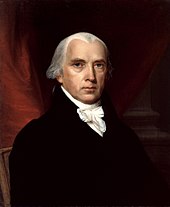Third Amendment to the United States Constitution
The amendment was a response to the Quartering Acts passed by the Parliament of Great Britain during the buildup to the American Revolutionary War, which had allowed the British Army to lodge soldiers in public buildings.The Third Amendment was introduced in Congress in 1789 by James Madison as a part of the United States Bill of Rights, in response to Anti-Federalist objections to the new Constitution.The amendment is one of the least controversial of the Constitution and is rarely litigated, with criminal justice writer Radley Balko calling it the "runt piglet" of the U.S.[11] Anti-Federalists such as Richard Henry Lee also argued that the Bill left the most objectionable portions of the Constitution, such as the federal judiciary and direct taxation, intact.[12] On November 20, 1789, New Jersey ratified eleven of the twelve amendments, rejecting Article II, which regulated Congressional pay raises.Virginia initially postponed its debate, but after Vermont was admitted to the Union in 1791, the total number of states needed for ratification rose to eleven.[15] In the words of Encyclopædia Britannica, "as the history of the country progressed with little conflict on American soil, the amendment has had little occasion to be invoked.[18] In one of the seven opinions in Youngstown Sheet & Tube Co. v. Sawyer (1952), Justice Robert H. Jackson cited the Third Amendment as providing evidence of the Framers' intent to constrain executive power even during wartime:[18] [t]hat military powers of the Commander in Chief were not to supersede representative government of internal affairs seems obvious from the Constitution and from elementary American history.Later, in Jones v. United States Secretary of Defense (1972),[28] Army reservists unsuccessfully cited the Third Amendment as justification for refusing to march in a parade.


Constitutionof the United StatesPreambleCongressional ApportionmentTitles of NobilityCorwinChild LaborEqual RightsD.C. Voting RightsHistoryDrafting and ratification timelineConventionSigningFederalismRepublicanismBill of RightsReconstruction AmendmentsNational ArchivesUnited States ConstitutionpeacetimeQuartering ActsParliament of Great BritainAmerican Revolutionary WarBritish ArmyJames MadisonUnited States Bill of RightsAnti-FederalistThomas JeffersonRadley BalkoCourt of Appeals for the Second CircuitEngblom v. CareyThirteen ColoniesBoston Tea PartyIntolerable ActsUnited States Declaration of IndependenceArticles of ConfederationConstitutional ConventionGeorge MasonVirginia's Declaration of Rightscivil libertiesVirginia Ratifying ConventionPatrick HenryBill of Rights 1689Richard Henry LeeArticle IIArticle IWilliam O. DouglasWar of 1812American Civil WarGriswold v. ConnecticutYoungstown Sheet & Tube Co. v. SawyerRobert H. JacksonFramersfederal courtNational GuardUnited States Court of Appeals for the Second CircuitFourth AmendmentincorporatedFourteenth AmendmentUnited States District Court for the District of NevadaDragonnadesList of amendments to the United States ConstitutionWikisourceWayback MachineConstitution of the United StatesAmendmentsReconstructionUnratifiedCorwin AmendmentDistrict of Columbia Voting RightsProposedBalanced budgetBlaine amendmentBricker amendmentCampaign finance reformChristian amendmentCrittenden CompromiseElectoral College abolitionEqual Opportunity to GovernFederal MarriageFlag DesecrationHuman Life"Liberty" amendmentLudlow amendmentParental Rights amendmentSchool PrayerSingle subjectVictims' RightsConvention to propose amendmentsState ratifying conventionsMount Vernon ConferenceAnnapolis ConventionPhiladelphia ConventionVirginia PlanNew Jersey PlanConnecticut CompromiseThree-fifths CompromiseCommittee of DetailList of FramersPrintingIndependence HallSyng inkstandThe Federalist PapersAnti-Federalist PapersMassachusetts CompromiseNew York Circular LetterHillsborough ConventionFayetteville ConventionRhode Island ratificationClausesAdmission to the UnionAppointmentsAppropriationsAssemble and Petition ClauseAssistance of CounselCase or ControversyCitizenshipCommerceCompactCompulsory ProcessConfrontationCongressional enforcementContingent ElectionsContractCopyright and PatentDouble JeopardyDue Process